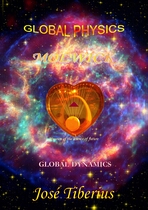3.c) Concept and definition of motion or movement
In the previous section, we saw concept of space and nature of time according to Global Physics, and its differences with Modern Physics.
We have also seen how concept of movement needed a third element, which is exactly what changes position in space over the course of time. This additional element is the reticular structure of matter or Global Aether (gravitational - kinetic - mass). Also, it fills up the entire universe, and it is elastic, unbreakable, and is the supporting medium for gravity, mass, and kinetic energy.

In short, the definition of movement is the displacement of kinetic aether or any of its parts –like LUM Aether (Luminiferous, universal, and mobile)– in Euclidian space over the course of absolute time.
The initial development of Global Mechanics did not seem to need any internal elements of kinetic aether –Global Aether– but, slowly, parts or sub-elements started to appear, to allow its intrinsic elastic properties.
The goal is to maintain the logic of scientific reasoning; therefore, any property of kinetic aether, whether it is internal or of a phase, should derive from some real, material, or physical characteristic. Otherwise, we would be talking about fictitious or non-existent properties. In other words, sub-reticular mechanics has not appeared yet, but it surely exists, since it will mean a deeper analysis than Global Mechanics, as the latter is to Newton's mechanics.

Let us see the difference approach to concept of movement between Global Dynamics and Newton's Laws. We can highlight the following characteristics:
-
The new definition of movement refers to Global Aether (gravitational - kinetic - mass) while Newton's Laws refer to movement of normal matter.
-
Global Dynamics has same concept of movement to various situations and, as a result, it follows diverse rules. Newton's Laws do not provide for motion of Global Aether, assumes motion takes place upon a completely empty space; consequently, they are partially correct in a space full of kinetic aether.
Broader range of motion concept in Global Dynamics eliminates the need for fictitious forces.
Newton's Fundamental Law of Dynamics established force as a proportion between mass and variation in the rhythm of movement; in short, a liaison between mass and energy applied. Regarding Einstein's Theory of Relativity, it recognizes this relationship to be constant, but it makes relative its units of space and time, and it introduces a quantitative function modifying mass at rest.
Global Dynamics sustains and generalizes relationship between mass and energy; it adjusts its quantification based on conditions. It also recognizes different forms of manifestation of this relationship, which outline diverse types of movement.
Definition of motion within Euclidean space and absolute time makes possible a concept of velocity with independent units from energy and gravity.
The reality does not depend on the observer, and magnitudes of velocity, force, acceleration, or energy are no more than properties of kinetic aether, in its different phases.
